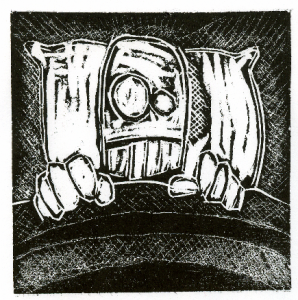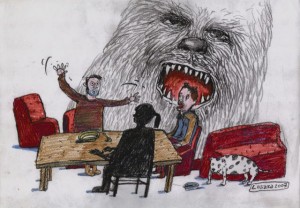Game Poem 35: Warriors of the Celestial Emperor
For centuries, the earth-bound warriors of the four celestial clans have fought each other to gain the favor of the gods. This battle will continue for many years to come, each element defeating the one before it, and defeated in turn by the next, as the great martial cycle wheels on through eternity.
This is a quick fighting game for two to four players, each taking on the role of a warrior from one of four ancient clans of warriors, vying against each other for the favor of the Celestial Emperor. This fight is but one of many, each victory bringing their order of martial artists to final victory.
To play, you will need a regular deck of playing cards. Each player will take the thirteen cards from one of the suits in the deck, as each suit represents a different school of warriors:
- Diamonds: Dragon Clan, from the East. Represents the element of Wind. Their color is Green, and their season is Spring.
- Hearts: Phoenix Clan, from the South. Represents the element of Fire. Their color is Red, and their season is Summer.
- Spades: White Tiger Clan, from the West. Represents the element of Metal. Their color is White, and their season is Autumn.
- Clubs: Tortoise Clan, from the North. Represents the element of Water. Their color is Black, and their season is Winter.
Each clan has a distinct fighting style. Dragon Clan warriors are swift and precise, and are said to sometimes be able to focus their energies to move the air itself against their foes. Phoenix Clan style is volatile and explosive, and adepts of this school can burn their opponents with a touch. Fighters of the White Tiger school are aggressive and relentless, and are skilled in the fabrication and deadly use of all manner of weapons. Finally, the Black Warriors of the Tortoise Clan have formidable defenses and a methodical fighting style that is bolstered by their power over water, both moving and still.
If there is a member of the Tortoise Clan present in this battle, they will describe the setting where the fight will take place. (If there is no Tortoise, then the White Tiger will detail the setting, or a Phoenix if there is no White Tiger.) Are the warriors meeting somewhere deep in a bamboo forest, next to a bubbling stream? Are they perched upon a cloudy mountaintop, or do they face each other in the moonlight atop the roofs of a village in the hills? Do they fight among the stones of a ruined temple, or in the courtyard of a palace?
Once your environs are decided upon, it is time to begin the fight! Dragon Clan warriors will always attack first, followed by each subsequent player in the cycle: Phoenix after Dragon, then the White Tiger, and then Tortoise, and back around to Dragon. It may be helpful for the players to sit in order, but it is not required.
To make an attack, the fighter will choose someone as a target, describe how they wish to attack that target, and place a card from their hand face down in front of them. Remember to be colorful and vivid in describing your attack, using any and all elements available to you, whether they be part of your Clan’s style or a piece of the setting. A Phoenix may lash out at their opponent with a whip of flame, or perhaps a White Tiger will slash their target with their dual Singing Jade Swords. A Dragon warrior might strike his foe with the legendary Coiled Cloud Fist, or maybe the Tortoise will maneuver his enemy towards a cliff that overlooks the sea, intending to send him over the edge, and onto the rocks below!
Whatever the attack may be, after the initiator has laid his card, their target will choose a card from his own hand and play it to the table as well. The players will then flip over their cards and compare the values. If the cards are of equal value, then the round is a tie, and both cards are discarded. The target of the attack may describe how the attack was nullified, but no advantage was taken by either side.
However, if one of the cards is higher than the other, the person with the high card wins this round of the battle. (Aces are low cards, and are beaten by every other card.) The victor describes how they either strike a powerful blow upon their enemy, if they were the attacker, or easily turn away the attack of their aggressor, if they were defending. After the victor describes their present success, the loser of the exchange then tells how they move away, into a different part of the setting, or alter or re-frame some part of the environment. So, for example, if a Dragon was successful in slamming a Phoenix warrior into the ground with a great gust of wind, the Phoenix may describe how they kick-spin up and run upstairs to the second story of the tavern, setting the room ablaze behind them, or they may blind the Dragon Clan fighter for a moment with a flash of heat, allowing them to run into the street outside. Perhaps a Tortoise Black Warrior sidestepped a White Tiger’s spear thrust, grabbing the weapon and neatly snapping it in two; the White Tiger may respond by flipping backwards and grabbing a pair of swords from the wall, or leaping up onto a chandelier!
After both sides get a chance to briefly describe the outcome of the attack, each player will take the card that the other player laid down and put it into their hand. After this exchange, each player will choose a card to discard from their hand – not necessarily the same card they just picked up – and place it on the table, face down. The winner of the attack will take these cards as a “trick” and place them in front of him to indicate that he has scored a victory. Neither player may look at the discarded cards.
When the round has ended, the next fighter in the cycle (Dragon -> Phoenix -> White Tiger -> Tortoise) will choose someone to attack, and proceed as above, describing their attack and playing a card, the target defending, and so on. Anyone may attack anyone else on their turn, until their hand has dwindled down to one last card. A player holding only a single card may neither attack nor be attacked, and must place their last card face-down in front of them to indicate that they are no longer in the fight. When no player is able to attack another player, either because they have only one card, or because there are no targets available with more than one card, the battle has ended, and it is time do determine the ultimate champion.
First, if there is a player left who has more than one card in their hand, they must discard down to a single card. However, each one of the cards that they discard counts as a trick for them! So, if the Phoenix won four rounds of fighting, and was the only one left at the end with three cards, they would discard two cards, down to one, which would give them six tricks total for the endgame. (This is a good reason to keep track of how many cards the other players have, and make sure that nobody is just standing by and not participating in the battle!)
Once every player has a single card left, everyone will reveal what their last card is. Each player will count the number of tricks that they have taken, and if there are one or more players whose final card is equal to or lower than the number of tricks that they have taken, the player with the highest card that is lower than the number of their tricks is the final winner of the fight! Ties are resolved by highest number of tricks taken, and then, if there is still a tie, by reverse order of play, beginning with the Tortoise, then the White Tiger, then the Phoenix. If no player has a final card whose value is lower than or equal to the number of tricks that they have taken, then the player who has the final card with the lowest value is the winner; ties here are broken the same way as above.
The ultimate winner may take a moment to describe how he has vanquished his foes, and then the other players may tell how they intend to return to fight again, continuing the warriors’ cycle.





